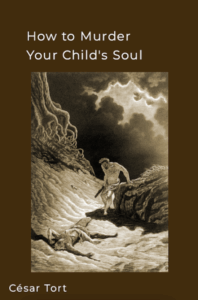Read this site’s featured article.
How to murder
your child’s soul

In November, The Occidental Observer published one of the chapters of this book, the complete English translation of which has just been released and is available here.
Hitler and the National Socialists had limitations. And I am not referring only to what I said in my article yesterday: that the Christian problem is more serious than the Jewish problem. The Nazis also failed by believing in biological psychiatry; specifically, that mental disorders are due to genetic deficiencies.
That is false, and this semi-autobiographical book proves it conclusively.
I would like to take this opportunity to thank Benjamin for his corrections to the English syntax. It is always difficult to write correctly in a second language.
Those racialists who have had mental health problems should read this book. It is liberating in a very specific sense. They must rid themselves of the demoralising idea that there is something wrong with their bodies, when in reality the only thing that happens to those who suffer from disabling mental stress is that they have been martyred by their parents.
Booklets, 1

German: Dich ruft die SS!
The darkest hour of the West is due to the extreme degeneration of white men, especially those Europeans who swallowed the propaganda of the American Diktat after World War II.
On the other side of the Atlantic, what “white nationalists” are incapable of understanding is that, as Matt Koehl said, a race that rejects Hitler will perish.
Among the noblest civilisations that defended their race—the Aryans who conquered India, Greece, and eventually Rome; the Vikings; and the Visigoths who killed those who dared to intermarry—, after the Judeo-Christian infection only the National Socialists intellectually developed a model of nationhood that fulfilled the sacred words. The others fell so short that they eventually Christianized like the Norsemen, or a thousand times worse: they intermarried.
Although Koehl’s eight words (“A race that rejects Him will surely perish”) should be displayed in every home of the brotherhood we wish to create, that doesn’t mean I share Koehl’s faithful orthodoxy, as we will see in this series on NS booklets translated into English.
On July 22, 2021, when I read the booklet pictured above, originally published in German by Himmler, I wrote on its blank pages:
Upon reading page 7, I can’t help but think that I shouldn’t visit the WN websites again, which are garbage compared to this fighting spirit.
It is precisely because the US is founded on that materialistic phrase containing the deceptive word “happiness” that it makes Americans the antithesis of the Aryan hero. But there’s a problem.
The problem I was referring to was page 10, where the author of the booklet, whether Himmler or one of his associates, wrote “…so help me God!”
The problem with imagining the deity in the singular is that it’s done under the umbrella of Jewish monotheism. An Aryan who wants to refer to providence would have to do so in the plural, “Gods,” inspired, let’s say, by the inscription of the Oracle of Delphi. Although the National Socialists, especially the pagan SS, were transitioning from Christianity to Germanic paganism, there were Jewish remnants in pronouncements like this one.
Given that after 1945 Christian ethics exploded in a secular way like a red giant star burning Aryan DNA around the globe, it’s necessary to recognise that this evil persisted, albeit to a minuscule degree, in translated booklets like this one.
Had the Nazi leadership realised this, they wouldn’t have launched insane wars of conquest (like Operation Barbarossa) but would have instead dedicated all their power to educating the masses in a kind of neo-Nietzschean racism, beginning with essays similar to Eduardo Velasco’s on Judea and Rome. They didn’t because, unlike us, the Nazis failed to grasp that the JQ wasn’t the primary cause of the Aryan decline but rather the CQ.
That said, there are many things I appreciate about the booklet, such as the fact that there was a group of SS members who were professional musicians. And by music, we obviously mean non-degenerate music (one of the enormous failings of the American racial right is their inability to make this distinction): music that inspires the highest ideals, like what I recently said about the Eroica Symphony.
Page 66 of the booklet begins with these words: “German parents! Sooner or later your son will become a soldier.” Reading this in 2021 reminded me that even the most radical of American white nationalists, the late Alex Linder, opposed National Socialism because he subscribed to individualistic libertarianism.
Let’s respond to Linder.
One of the greatest damages caused by “introducing spiritual terror” (Hitler’s words) to the Aryan collective unconscious is precisely that it atomized it: from a collective, whites became atomized particles, “souls” whose main purpose was to avoid eternal torment in hell. The spiritual terror finished off the racial solidarity that had already declined in Imperial Rome.
Even anti-Christians like Linder never understood that it wasn’t enough to repudiate the dogmatic part of Christianity, but rather the axiological part as well: like this transition from collectivist societies like Sparta and Republican Rome to imperial degeneration. One of the most notable features of the decadent religions that arose in the Mediterranean is that, unlike their ancient predecessors, they were religions of personal salvation—and I’m not referring only to Christianity (cf. Richard Carrier’s work on the plethora of Mediterranean religions in the Roman Empire).
On page 87 of the booklet, which mentions many colours of Waffen-SS insignia, I learned that the colour used in concentration camps was light brown. As several visitors know, last year I visited Dachau outside Munich: a place I love because unlike, say, the feminized Groypers, the goal there was to eliminate internal opposition including rebellious Christians. Recall the words of a Christian I quoted last month:
He [Hitler] filled Dachau with Catholic clergy; hundreds were worked to death or died under medical experiments.
Bishops who preached against euthanasia faced arrest.
The Gestapo dissolved every independent Catholic youth organisation in Germany. Catholic newspapers were banned, publishing houses seized, and confessional schools closed or converted to state use.
The Concordat he signed in 1933 was violated before the ink dried.
In his own recorded words, he called Christianity “an invention of the Jew” and “the heaviest blow that ever struck humanity,” declaring that the Church would be eradicated once the war was won. His inner circle confirmed the plan was total.
Pius XI answered with Mit brennender Sorge, the only encyclical in history smuggled into a country and read from every Catholic pulpit on the same Sunday, condemning the idolatry of race and blood, and National Socialism itself, by name.
Condemning “the idolatry of race and blood”! Actually, it was magnificent to have condemned the worshipers of the god of the Jews, those rebellious Christians, the true idolaters. Loving your blond sons and blue-eyed daughters isn’t idolatry!
Do we finally understand what Nietzsche meant when he said that Christianity had inverted the values of the Greco-Roman world? If I were the dictator of the US and an insolent disciple of Nick Fuentes rebelled publicly against these types of measures, I would undoubtedly send him to the American incarnation of Dachau.
Peter Pan
Today I’m giving my brother the first two volumes of my autobiographical trilogy. The fact that my surviving siblings haven’t read it is, in itself, proof of how normies repress family tragedies at all costs, even if they’ve witnessed some of them.
I’ve been highlighting on this site that fairy tales contain profound messages about the mistreatment of children by their parents, provided we recognize that adaptations like Disney’s have little to do with the original stories. Yesterday I watched with interest this video:
When James Barrie was a child, his older brother David died a day before his fourteenth birthday from a fall while ice skating. The effects of his death drove their mother mad, and were described at length by Barrie himself years later in the fictionalized biography Margaret Ogilvy: By Her Son, where he addresses in detail the feelings and emotions of young James, his strategies for helping his mother overcome the deep depression into which she had fallen, and his attempts to offer himself as a kind of replacement for the deceased boy.
“Offering himself as a replacement” means that Barrie sacrificed his true self due to his mother’s profound depression: a drama symbolized by Peter Pan, a character he created for a play that premiered in London in 1904.
Peter Pan is a boy who never grows up, is ten years old, and hates the adult world. The figure of Peter Pan is inspired by the Llewelyn Davies brothers. Barrie developed the idea for Peter Pan from his time spent with and friendship with the Davies children. He often performed small plays with the Davieses and actively participated in their childhood games.
But the most sinister aspect of the matter is that the commandment “thou shan’t grow up,” with which Barrie’s mother’s horrific depression had programmed the mind of her surviving son, was perpetuated by Barrie himself when he adopted these children after their parents died—watch the video above. Trauma demands repetition: something similar to what Beethoven did to his nephew, whom he also adopted and mistreated (the nephew, as an adult, attempted suicide by shooting himself in the temple), due to the abuse Ludwig van Beethoven’s father had inflicted on him as a child.
But that’s another story…
Webbon’s
interview – 1
“For me, the overall result is the visible and systematic poisoning of the youth of our people through Christian education…” —Himmler to Bormann (see the bibliographic source for this letter in my article from yesterday).
Yesterday, the first hour of a ten-hour series of Nick Fuentes’ interview with Christian nationalist Joel Webbon was uploaded on YouTube.
At the beginning of the interview, we see that Nick is infinitely closer to Christian nationalism than to white nationalism (recall that in his interview with Tucker, Nick said he was a white nationalist but not at the level of William Pierce’s WN, his words). Obviously, neither Fuentes nor Webbon are National Socialists.
Shortly after, Nick says that the US should have a Christian government. Compare this to what Richard Weikart says about Hitler’s esoteric anti-Christianity, in contrast to the Führer’s exoteric image (prolefeed for the German proles).
Soon after, both say things that go against the US Constitution, such as that the government should not pass laws regarding the establishment of a religion. Then Nick mildly approves of the interviewer’s crazy idea of implementing blasphemy laws in the US: something that would overturn the First Amendment. Interestingly, as a gospel follower, Nick doesn’t want the death penalty for most murderers, but he does want it for those who desecrate the consecrated host or wine.
Only at this point does Nick speak about secular racialism, and they even briefly touch on the topic of our worldview, which we might call anti-Christian racism. Nick confesses that his Groyper movement was precisely a reaction against that secularized racialism: a step back towards American traditionalism.
The interview ends with Nick expressing his desire for an alliance between his America First ideology and his interviewer’s Christian nationalism. Their movement represents, in my humble opinion, the last-ditch effort of American Christianity.
Noonday demons
On this second day of the year, I would like to elaborate a little on what I have been saying recently about depression.
If Kali Yuga is pure poison for the priest of the sacred words, how can one find some encouragement?
Encouragement comes naturally through dedication, but only when that work is aimed at preserving and advancing the 14 and 4 words, which define the purpose behind my struggle. What happens when virtually all Aryans have degenerated, and no one is properly fighting for those words?
I can entertain myself for a few minutes a day on X, as there are several neo-Nazis who speak as I usually speak. But all of them lack a plan for how we are going to take power. For such a plan, we would need to live very close together, always eat together as in the Spartan syssitia, and conspire on how we could wake other whites from their catalepsy.
That alone would lift the spirits.
But I have no one in this third-world metropolis with twenty million non-whites to talk to. And the saddest thing is that Western racialists living in predominantly Aryan towns also have no one to talk to in their cities or villages.
A normie works for more comfort: his deity is the god of riches, Mammon. For us, if there is such a thing as following the decrees of providence, these are the sacred words.
But what can a priest do in the darkest hour?
Basically, get depressed because white nationalists are, as we have seen, de facto conservatives and have no plan to take power in their nations.
If Russia’s entry into Kiev fatally disrupted the traitorous European governments, my spirits would rise because that could mark the beginning of the end of Kali Yuga.
But that’s not happening yet…
The horrible dilemma that a priest on the other side of the Atlantic and I suffer from is that it is impossible for us to wait passively for that collapse because that wait leads to exasperating depression.
What to do then?
If there were already several priests, even if we didn’t live together, we could try to do something on Rumble. The West’s Darkest Hour has already been exhausted in the written word, but audio-visual communication, if it were every day, would reinvigorate this blog.
But even that is not possible due to the language barrier (I write in Spanish and then convert the text into English with a free online translator; then I correct the software’s syntax).
That condemns me to a purely textual blog, although if I already had young pupils aspiring to the priesthood, they would be using A.I. to translate my audio-visual monologues into English. But I have realised that I don’t work well when I’m just talking solo to the camera. I need at least one other person to interact with verbally.
It seems incredible, but for a Kalki apprentice like me, what would lift my spirits the most would be a nuclear exchange between Europe and Russia so that the System would be destroyed in a single day, even though in the coming months I could die from nuclear winter if the US committed the stupidity of intervening.
Nuclear fantasy aside, what would lift my spirits stratospherically would be to live with people who think like me. I couldn’t live with the Groypers, for example, because they have no plans for ethnic cleansing in the US. It has to be someone who religiously believes in the 14 words. And if another man also believes in the 4, he would be a brother, a soul mate.
What to do in a city where one is a sort of Diogenes going out with a lamp in broad daylight to find a single man and never seeing him? How can one not get depressed if we add to that the fact that white nationalism is phoney (unless someone vehemently believes and speculates in scenarios like The Turner Diaries)?
Every single day becomes a struggle against the noonday demons, for which I am not in the least bit to blame. The culprits are the millions of Aryan males who are doing nothing: lambs to the slaughter of the anti-white System that covers the West.
Would a way to entertain myself in the coming days be to offer constructive criticism of the Third Reich pamphlets I own? Years ago, I realised that the exoteric part of National Socialism lacked the depth of the esoteric part.
Himmler in letter to Bormann on how Christian education has poisoned our youth:
“We already have the best contact with the Reich Youth Leadership. But I think the report is so important that I didn’t want to withhold it from you. For me, the overall result is the visible and systematic poisoning of the youth of our people through Christian education, which we obviously do not provide enough positive ideological education for in our youth, especially now in wars.” [1]
Part of my depression stems from the despair that more than eighty years ago the Germans had hit the nail on the head. In contrast, today’s American racialists (Europeans are punished if they dare to speak out, as happened to Brigitte Bardot) cling to Judeo-Christianity: the primary cause of white decline.
__________
[1] Source: NARA, RG 242, T-175, Roll 131 p.640, National Archives.
2026

The editor of The West’s Darkest Hour in Spain, in the place and year he discovered white nationalism on the internet.
The previous year was a terrible one for me for reasons I won’t elaborate on. Only if the following happens this year could I be consoled:
• That the dollar not only slides in favour of gold and silver, but that compared to precious metals it hyperinflates becoming confetti.
• That the Russians enter Kiev and, due to recent European threats, basically take over Ukrainian territory so that, once defeated, the Ukrainians can no longer rearm themselves or dream of belonging to NATO.
Although if I had absolute power I would conquer all of Russia for a Fourth Reich honouring the will of the Führer, what matters now is that the anti-white system—represented by the European Union, NATO and the United States—perish. And the two points above, taking into account that the European fiat currencies have been pegged to the dollar since the Bretton Woods agreements in 1944 (when the Hellstorm Holocaust against the Germans was already beginning to be perpetrated), would be blows that would mark the beginning of the death of the System.
That the Russians will win in Ukraine, and that victory will annihilate NATO and the European Union, is something that several pundits have been predicting in the alternative media, both in English and in my native language. But that a Russian victory will fulfil Putin’s dream of returning to the gold standard, reversing the Bretton Woods agreements (and causing the dollar to collapse) will probably happen later.
Once the anti-white System begins to crumble, my golden dream is that a few zoomers will begin to repudiate the Christian ethics of white nationalists like Nick Fuentes and become spokespeople (say, on Rumble) for the sacred words.
But the latter is already too much to dream of…
New book
Below text by MythVision Podcast
(watch it here)
 Join Derek Lambert for a live round-table with Dr. Richard Carrier, Dr. Richard C. Miller, and Dr. Aaron Adair as we dig into Carrier’s provocative new book, The Obsolete Paradigm of a Historical Jesus—and why he thinks parts of biblical studies (and even peer review) keep dodging the core arguments.
Join Derek Lambert for a live round-table with Dr. Richard Carrier, Dr. Richard C. Miller, and Dr. Aaron Adair as we dig into Carrier’s provocative new book, The Obsolete Paradigm of a Historical Jesus—and why he thinks parts of biblical studies (and even peer review) keep dodging the core arguments.
Carrier surveys a decade of responses to his and Raphael Lataster’s work and finds that many critiques avoid the actual evidence and logic, a pattern he says signals a deeper problem in the field.
A big theme tonight: why historians “must learn math.” Carrier argues that historical conclusions need explicit logic and probability—Bayesian reasoning—rather than gut feel or ad-hoc explanations.
We’ll unpack priors, likelihoods, and how to tell when we’re explaining evidence vs. explaining it away. The new book also hit several hot-button texts where Carrier says traditional readings are too thin to prove historicity:
- Romans 1:3—ambiguous and compatible with non-historical interpretations, so it can’t carry the case.
- Galatians 4:4—part of an allegorical argument, not a plain biographical claim.
- “Brother of the Lord”—in earliest Christianity, all baptized believers saw themselves as Christ’s siblings, which complicates appeals to this phrase as biographical proof.
Plus: Docetism—Carrier’s new book contends the modern category is a misconstruction of scattered ancient ideas and later polemics. We’ll examine what ancient sources actually say. Whether you agree or not, this conversation aims to model rigorous critical debate about evidence, method, and how scholarly paradigms change.
Repudiation
I recently listened to an entire debate between Richard Carrier—whose scepticism about the historical Jesus I admire—and a Christian nationalist. The debate highlighted the big ideological differences between secular humanists and Christian nationalists.
I was greatly surprised that, when it comes to the 14 words, although the Christian nationalist is not a Nazi like us, he is much closer to our side because he is concerned about mass migration to the West. On the other hand, Carrier approves of the mass migration of coloureds that metamorphosed Canada and Sweden! Carrier also doesn’t care about the sexual dissipation that has been destroying the white race in recent decades.
I believe that Gaedhal, whose text mentioning Carrier I published on Saturday, is right to speak of “atheistic hyper-Christianity”. Folks like Carrier have abandoned belief in God and the historicity of Jesus—at the cost of hypertrophying suicidal Christian ethics: what I have been calling neochristianity on this site. Do you recall this passage from a seminal article on this site by a Swedish blogger?:
Secular Christianity has thrown out God and Christ, but keeps the Christian ethics (inversion of values, etc.). And the Christian ethics actually gets heightened and unfettered in Secular Christianity (I have written much about that in my blog).
With Christ as part of the equation, the Christian ethics of the Gospels became balanced. Humans were seen as imperfect, and it was Christ who covered for us with his self-sacrifice.
In Secular Christianity, each person must be like Jesus himself, practising self-sacrifice, since there’s no other way to realise Christian ethics. On top of that, with the Industrial Revolution and the surplus it created in our societies, we came to the point where all the good deeds of Christian ethics could finally be executed by giving off our surplus to all the poor and weak foreign people around the world: food, Western medicine, and other aid.
It is incredible the damage that Christianity still causes to so-called freethinkers, agnostics, atheists and secular humanists—all of them clueless of the fact that their scale of values is a secular embodiment of the Gospel message.
Racialist Christians aren’t much better. Nick Fuentes recently responded harshly to Vivek Ramaswamy, an Indian living in the US. However, he added that if the Indians’ grandchildren wholeheartedly accepted American culture, Nick could consider them for entry into his country. This contrasts with the priests of the sacred words who desire a far more extreme outcome—one resembling the ethnic cleansing described in William Pierce’s novel.
The priest repudiates both atheists and Christians, and if he had the power, he would replace the Christian/secular humanist paradigm with Hitlerism.
Himmler quote
César,
by Gaedhal
I am not a Randian Libertarian, but one thing that she got right is that we are at home upon the earth. The Orthodox anchorite is not at home upon the earth, which is why he is climbing a ladder to “Heaven” to escape it. Take a look at some of these Orthodox icons. They can be really trippy:
The earth is presented as a sterile desert… because Christianity was, originally, a desert religion.
As we discussed on your blog, César, there is probably a Schopenhauerian, Pessimistic, Benetarian, Antinatalist, EFIL-ist interpretation to these icons: better to have never been, and second best is to deny the will to live, and to annihilate oneself, through ascesis and chastity/celibacy, so as not to burden another generation with the “pain and boredom” of life, as pessimists put it. As Jesus himself said: let he who can take castration, take it. One of the things that Antinatalists often do is get vasectomies. Richard Carrier has gotten a vasectomy, which is why I suspect his being an Antinatalist.
In my view, “Jesus”, is merely Nirvana, the “breathed-out state”, as Alan Watts put it, i.e. the “all-sufficient void” as Schopenhauer put it. It is conjectured by the likes of Richard Carrier that there was an adept Christianity, that is now lost to us, wherein the obviously fictional life of Jesus was understood as a parable. The Christian adepts understood that deceased Jewish carpenters do not respawn and float off into the sky. Dominic Crossan, my fellow Ulsterman from the lost county of Donegal, also believed that Jesus’s entire life, as recounted by the gospels, and especially the original gospel, the gospel of Mark, is a parable.
But a parable for what? Who knows? But given that we know that there were Antinatalist Buddhist preachers/missionaries in the Levant, since around 100 BCE—see mythicist papers for more on this—perhaps Christianity is a parable for the various forms of Pessimism, listed above.
If John of Patmos had an IQ north of 80, then he too would have understood that Jesus’s life was a parable. Again, virgins don’t give birth, and dead Jewish carpenters never respawn and levitate into the sky… there are no exceptions to this. I am putting money on the fact that the Jewish con-artists who wrote the New Testament understood this as well. Thus, the true end to the Book of Revelation would be the earth melting in fervent heat—as pseudo-Peter sayeth in an epistle—and the sky being rolled up as a scroll. The sky was a physical thing in those days, preventing the primordial waters from drowning us all. Thus, the Revelation is an EFIL-ist parable where the ideal state is the destruction of the planet. Revelation is a 2nd-Century C.E. version of the Red-button EFIL-ist thought experiment. The “New Heavens and the New Earth” is merely for the non-adepts, for the profane.
As Schopenhauer says: he is practising true Christianity, and in my view it could actually be the original version of Christianity.
And here is the website where Salm explores the link, perhaps direct, between Buddhism and Christianity. We know that there were Buddhist proselytizers from India in the region, at about the turn of the era, in about 1 CE.
However, it could just be a case of independent convergence. This is a hell-planet where living things must kill and eat other living things to survive. This is the Darwinian problem of evil [emphasis added by Ed.]. No sensible or ethical god would have created a system like this. This is why I view “theistic evolution”, such as that promoted by Biologos, to be every bit as delusional as creationism. To me, Pete Enns is every bit as delusional as Ken Ham. Once we introduce gods to evolution, then it becomes intelligent design. Theistic Evolution is an oxymoron to me.
Given that this is a hell planet for most sentient beings, then the thought often independently arises that it were better to have never been. The Jesus movement need not have had a formal connection to Buddhism to come up with Pessimism and Antinatalism—let he who can receive [castration] receive it—on their own.



